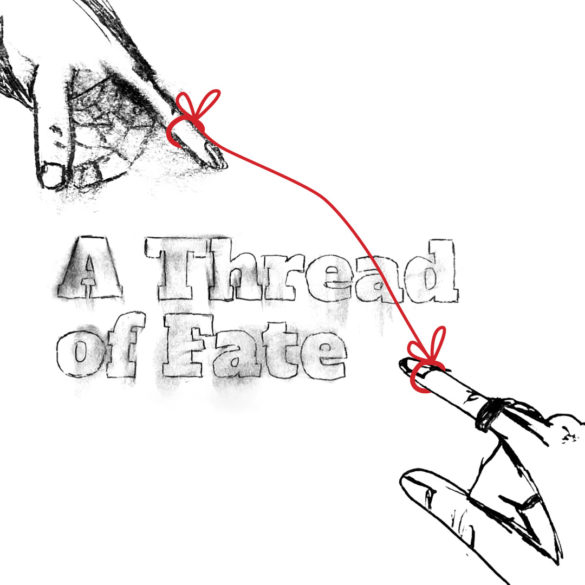Amanda Erk always thought her parents met in a twist of fate.
Her dad, Bob, was 18 years old and stationed in Texas for the Air Force. He often found himself feeling bored during his free time and complained about this to one of his fellow soldiers, Buddy.
Buddy told Bob that he should write to his wife’s younger sister, Karen. He handed him a photo of her and promised that she loved to write and would for sure write back to him.
So, Bob wrote Karen a letter.
Even though Buddy promised she would write back, Karen never did. Buddy had given Bob a photo of Karen that he’d sent in his letter along with a photo of himself.
To her disdain though, the photo was her sophomore yearbook picture, taken right after gym class. Mortified, she didn’t write back.
Eventually though, Bob and Karen’s paths would cross again, leading them to officially meet, date, and later, marry.
The idea of two people or two experiences coming together at the right time is the premise of the theory of synchronicity.
According to Psychology Today, the theory of synchronicity was first founded and defined in the 1900s by Carl Jung, a psychiatrist and psychoanalyst.
The idea of synchronicity can be viewed as meaningful coincidences. The theory runs on the idea that two unlinked, individual experiences can be interlaced.
Other examples of synchronicity may be seeing the same number or word repeatedly, or something as coincidental as dreaming about someone, then running into them in person.
It’s not uncommon for those who experience a synchronistic event to believe it’s a sign from some higher power, however, a majority of scientists believe these events are simply coincidental.
For Karen and Bob, their story only became more synchronous when Karen found herself working at a restaurant a year later.
The restaurant Karen was working at had a specific layout in terms of the break rooms. The women’s break room was kept separate from the men’s, but everyone had to clock in and out on the side of the women’s.
She had some male coworkers needing to be clocked out, so she offered to do it for them. Her coworkers, one being new, only referred to as “trainee Bob,” gave her their timecards.
Karen recognized trainee Bob’s last name as soon as she saw his timecard. It was the same as that boy who had written to her from a Texas Air Force base.
After clocking them out, Karen decided to get to the bottom of this. She walked back over to her coworkers.
“Were you in the Air Force?” She asked Bob.
“Yeah, why?” He wasn’t rude, but rather clip. She kept going.
“Did you do basics in Texas with a guy named Buddy?”
“Yeah, why?”
She’d heard enough. She pulled out her wallet and showed him a picture.
It was Bob’s photo he had sent to her in that letter. Even though she never wrote back, she’d always kept his photo in her wallet.
Karen and Bob like to say the rest is history after this reconnection. He initially felt bad about the whole encounter and begged Karen to let him take her out, which she declined several times.
One day though, Karen accepted the offer. They arranged a pizza date. Bob knew this was the woman he was going to marry.
Three to four weeks after their date, they were married. Even more coincidental, when Karen was trying on wedding dresses, she was unknowingly fitted by Bob’s cousin. She didn’t learn of this relation until her bridal shower the next day.
Amanda says when telling her this story, Karen would say,
“Sometimes, you just have to read the signs.”
Ball State assistant professor of art Kristin Reeves also experienced the phenomenon of synchronicity years ago when she was in New York City for a conference.
One night after the conference, Kristin and about 50 other artists went to a satellite event for experimental cinema in relation to art. The event featured screenings and simple conversations. Afterwards, Kristin found herself walking to the subway alongside a fellow conference-goer.
They started to chat. He had asked her where she was originally from.
“Well, originally Indiana, but a small- town in Indiana,” she told him.
To her surprise, he revealed he was also from a small town in Indiana. She shared that her hometown was close to Fort Wayne. He said the same.
Even more coincidental, when she told him she was from the town of Huntington, he shared that that was also his small hometown.
Their conversation led them to talk about where exactly they lived in Huntington. Kristin told him she had lived on a country road that didn’t really have a name.
Somehow, two former strangers who had both lived in the same town two doors down from each other were now walking the same street in New York City together.
The other artist she was talking to was a little older than Kristin, explaining why she never knew him personally.
Their conversation later revealed other small connections the two had, beyond just similar Facebook friends. The man’s dad was her family’s insurance provider. When Kristin’s brother had been in two small car accidents in a row, the artist’s dad came to her house to sort things out.
Kristin hesitates to say it was fate but thinks some kind of force causes people’s paths to cross.
“[It] makes us take notice of how small the world can be sometimes,” she says.
This synchronous meeting also made her wonder about their experiences growing up and how they both ended up interested in the same field of art.
“We were both looking out at the same landscape and now we’re both pursuing similar paths,” she says. “[This kind of visual career path in art] wasn’t something either of us knew anything about because it didn’t exist in our world.”
She describes the experience as “remarkable.”
Kristin’s coincidences surrounding her hometown don’t stop there. Kristin is from Huntington, Indiana, whereas her husband grew up in Huntington, New York.
While there isn’t an exact reason as for how these coincidences happen, they have the ability to change a person’s life.
For Bob and Karen, this was their marriage. Their synchronous union is now coming up on its 48th anniversary
Sources: Psychology Today




